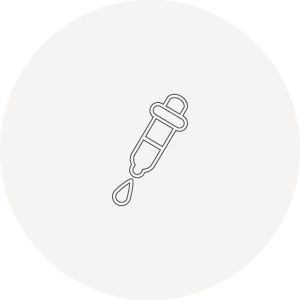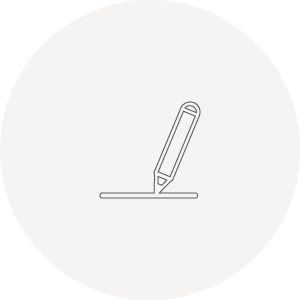Brief Overview of Autologous Fat Transfer (Lipofilling)
The loss of subcutaneous fat tissue and the decrease in connective tissue elasticity are natural consequences of aging. Many people wish to counteract these visible signs of age. Whether for lip or facial augmentation, hand rejuvenation, or buttock enhancement — lipofilling can be applied to almost any area of the body.
More and more women who desire larger breasts but wish to avoid silicone implants are choosing this method. Through autologous fat transfer, the breasts can be naturally and permanently enhanced, resulting in an aesthetically pleasing, full, and natural-looking shape that feels completely natural to the touch.
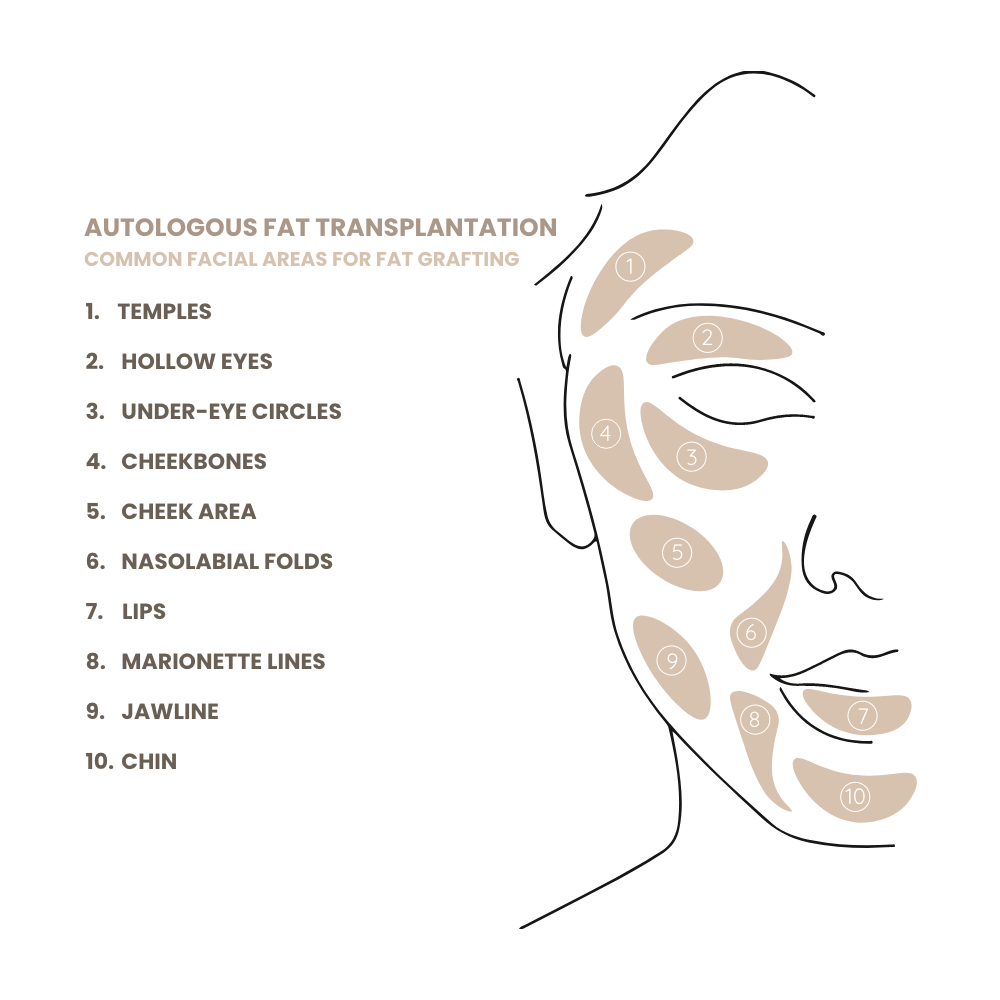
Lipofilling: Combination of Liposuction and Autologous Fat Transfer
Lipofilling — also known in medical terms as autologous fat transplantation or simply fat grafting — is a technique used in both reconstructive and aesthetic surgery. In this procedure, a patient’s own fat is used to fill wrinkles in the face, refine scars, smooth out dents, add volume to the buttocks or breasts, or improve the shape of various body regions (body contouring).
The fat is usually harvested from the thighs or abdomen, although in principle, it can be taken from any area where sufficient fat is present. The extraction is performed using a particularly gentle liposuction technique to minimize damage to the fat cells. The harvested fat (lipoaspirate) is then processed and purified before being injected into the desired area using a fine cannula. By injecting the body’s own fat cells, volume is naturally restored or enhanced in the treated regions.
Because autologous fat is the body’s best and most natural filler, it allows for long-lasting and harmonious results when properly prepared. It is crucial that as many transplanted fat cells as possible survive — only if enough of them successfully integrate (take root) can durable improvements and contour refinements be achieved.
The modern equipment used in our clinic, combined with refined techniques for both fat harvesting and transplantation — as well as our decades of experience (over 2,000 procedures to date) — ensure a high survival rate of fat cells, low complication rates, and consistently satisfying results.
Since only the patient’s own tissue (fat) is used, there is no risk of intolerance or allergic reaction.
Applications of Autologous Fat Transfer
The applications of autologous fat transfer can generally be divided into two categories: reconstructive and aesthetic.
Reconstructive fat grafting is performed when a loss of volume has occurred as a result of an accident or surgery. The best-known example is breast reconstruction after cancer surgery, where the lost volume can almost always be restored. Another important application is the treatment of painful or contracted scars, which may develop after infections, trauma, surgery, or radiation therapy. In these cases, the scar tissue is mechanically loosened, and fat is injected to improve the scar’s appearance and often relieve pain — the stem cells contained in the fat play a key role in this healing process.
In the aesthetic field, autologous fat can be used wherever volume enhancement or contour improvement is desired. This includes the face, breasts, buttocks (Brazilian Butt Lift – BBL), and body contouring (e.g., hip dips).
In the face, virtually every region can be refined with experienced technique. The integration rate of fat cells in the face is particularly high, meaning that only one or two sessions are typically required. The most commonly treated areas are under-eye hollows, followed by nasolabial folds and lips (which, due to their constant movement, have the lowest integration rate). Other frequently treated areas include hollow upper eyelids, the cheekbone region, midface, cheeks, and increasingly the temples and jawline, to enhance the definition of the lower face.
Breast augmentation with autologous fat has experienced a remarkable boom in recent years, especially as more women choose to remove silicone implants due to long-term side effects such as capsular fibrosis, pain, or unnatural appearance.
Similarly, Brazilian Butt Lifts (BBL) are now predominantly performed using fat transfer, as this method produces completely natural results. For body contouring, fat grafting is essentially without competition — as it allows for the almost magical reshaping of the body by removing fat where it’s unwanted and adding it where volume is lacking.
For all large-volume fat transfer procedures (such as breast augmentation, BBL, or body contouring), it’s important to remember that two goals are achieved at once: the donor area (e.g., abdomen, “love handles,” thighs, or arms) is sculpted, while the recipient area gains volume — all within a single procedure.
Facial Wrinkle Treatment
In the facial area, autologous fat injection not only restores lost volume in regions such as the cheekbones and midface, but it also provides a hydrating, tightening, and rejuvenating effect on the skin — thanks to the stem cells naturally present in fat tissue. In some cases, a successful lipofilling can even make a facelift unnecessary.
Autologous fat can also be used for lip augmentation or to fill deeper wrinkles. Treatment of the entire facial area (temples, under-eye hollows, cheekbones, nasolabial folds, lips, cheeks, jawline, etc.) can be performed in a single session.
Smaller wrinkles are treated using microfat, which is particularly finely processed and injected through very thin cannulas (0.8 mm in diameter).
Nanofat is produced when the harvested fat is broken down even further, destroying the fat cells and isolating stem cells. Nanofat is therefore not a filler, but rather a regenerative stem-cell concentrate used to improve scars, skin tone, and texture, as well as for facial rejuvenation, gynecological applications, and even hair restoration.
Scar Correction
Because fat tissue — due to its stem cell content — has a regenerative and healing effect, adherent or retracted scars can be smoothed and improved through fat injection. The tissue becomes more supple, and the contour is evened out. You can find more details under “Scar Correction.” Scars on various parts of the body can thus be gently and permanently improved.
Breast Reconstruction After Capsular Fibrosis
For patients suffering from advanced capsular fibrosis after breast augmentation with silicone implants, lipofilling is an excellent solution. In most cases, no new implant is required to maintain the same breast volume. The implants are removed, and during the same procedure, the breasts are refilled with the patient’s own fat tissue — leaving no new scars.
Because the breast tissue is already pre-stretched by the previous implant, the integration rate of the fat is particularly high, and one single operation is often sufficient.
Breast Augmentation with Autologous Fat
For women who wish for fuller, rounder breasts without silicone implants, breast augmentation with autologous fat is a highly effective and long-lasting method.
Besides avoiding the typical long-term complications of implants (capsular fibrosis, pain, unnatural appearance), the decisive advantage of fat transfer is that the breasts look and feel completely natural, move naturally with the body, and are not colder than surrounding tissue.
Depending on the patient’s BMI and natural breast size, an increase of two or more cup sizes can be achieved, though multiple sessions may be necessary. For women over 30, a breast ultrasound or mammogram is recommended before the procedure.
The treatment is minimally painful and low in strain. Only tiny puncture scars remain — 3–5 mm in the donor areas and 1–3 mm in the breast.
After three months, 25–70% of the transferred fat may be reabsorbed, and additional sessions can be performed after about three months if desired.
Buttock Augmentation with Autologous Fat
Similar to breast augmentation, the buttocks can be enhanced through lipofilling (Brazilian Butt Lift – BBL).
Larger amounts of fat can be injected compared to breast augmentation — provided there is sufficient donor fat available.
Important safety note: The BBL procedure is only dangerous if fat is injected into or beneath the gluteal muscle (risk of fat embolism). When fat is placed above the muscle, the procedure is as safe as breast augmentation with fat.
Other Possible Applications
- Correction of soft tissue defects
- Improvement of general skin quality
- Treatment of skin damage after radiation
- Treatment of burn scars
- Aesthetic corrections of other body regions (e.g., hands)
- Penis augmentation
- Enlargement of the labia majora (intimate correction)
How is autologous fat transfer performed?
The autologous fat transfer consists of three phases:
- Harvesting the fat
- Processing the fat
- Injecting the fat into the recipient area
The specific approach depends on whether a small or large procedure is planned — techniques and equipment are adapted accordingly to achieve the most natural and lasting result.
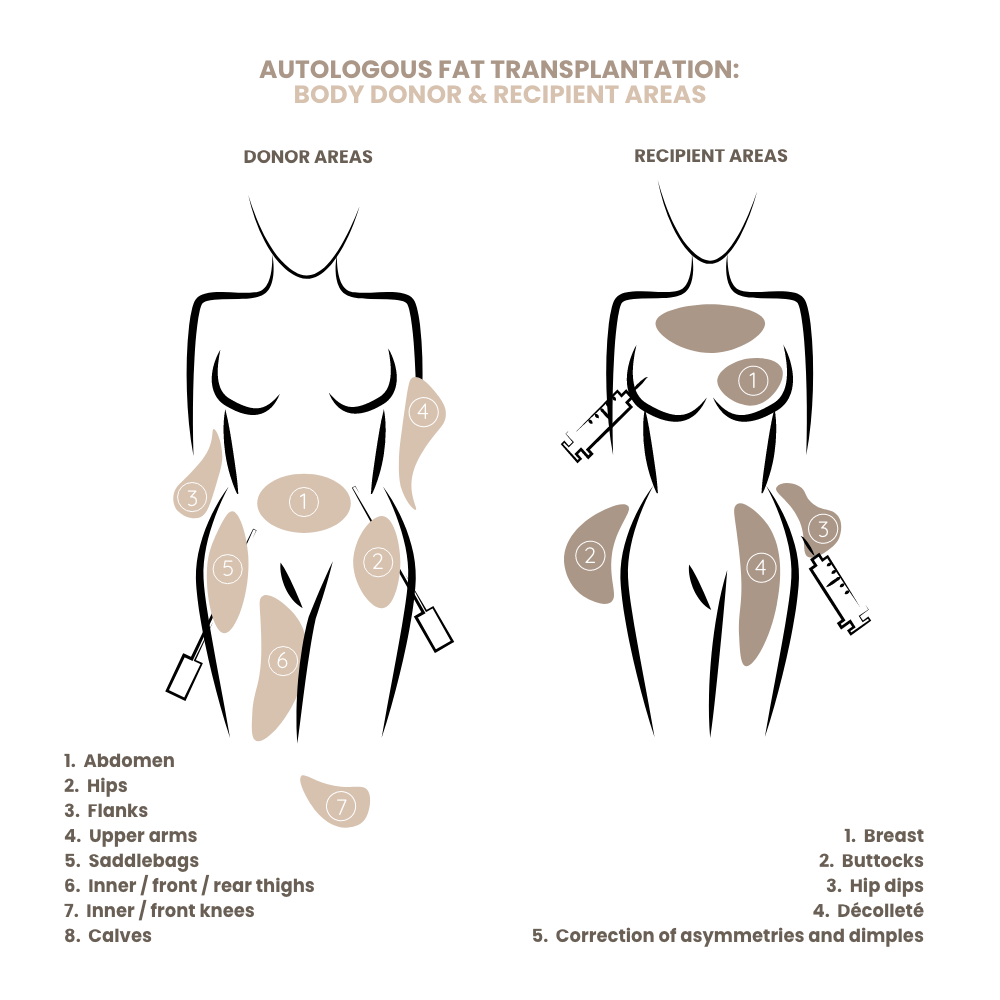
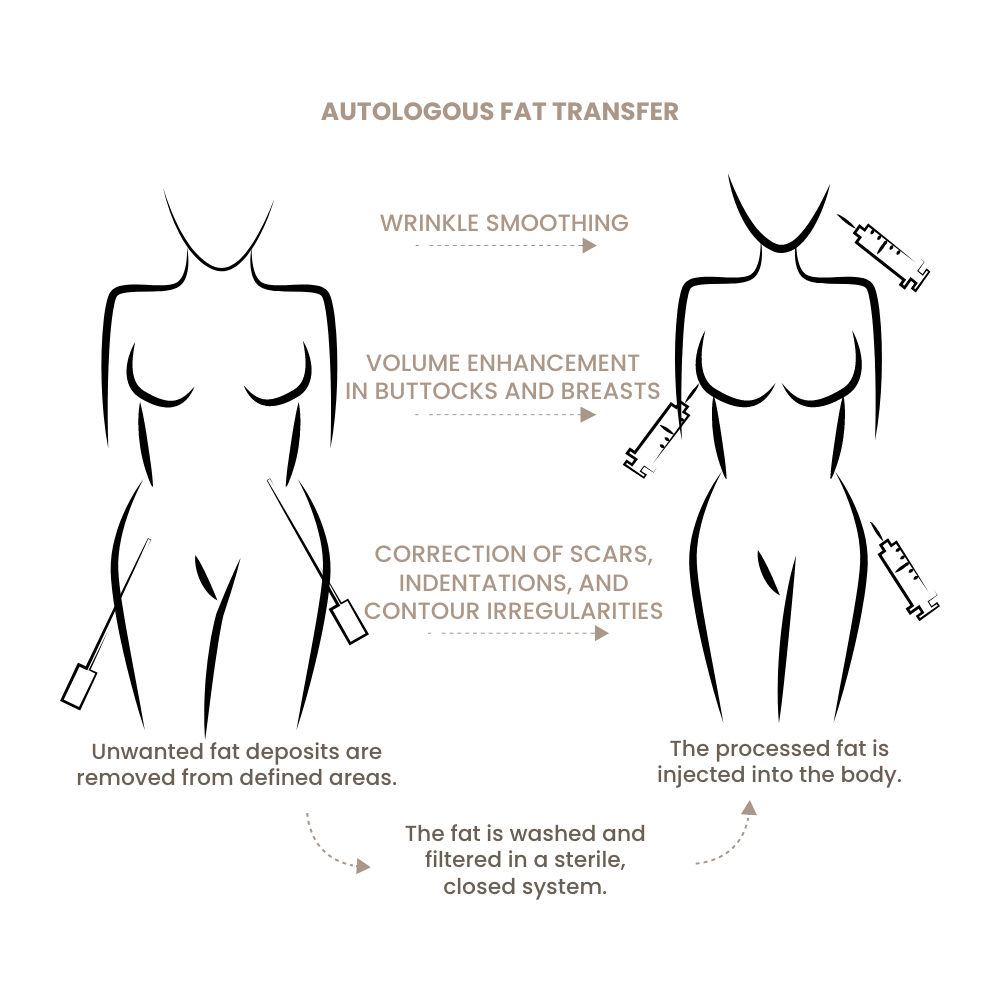
For smaller procedures:
For small amounts (e.g., under-eye hollows), a local anesthetic is injected into the donor area, containing a vasoconstrictive substance to prevent bleeding. The fat is then gently harvested manually using a thin, blunt cannula (1.5 mm in diameter).
The harvested fat is centrifuged, resulting in two or, with stronger centrifugation, three layers: a watery layer at the bottom, a cellular layer in the middle, and (with longer centrifugation) an oily layer on top. The watery and oily layers are discarded, leaving only the cellular layer containing intact fat cells.
These are then transferred into a 1 ml syringe fitted with a blunt cannula (0.8–1 mm in diameter) for injection. The fat is then carefully transplanted — as the syringe is slowly withdrawn from the recipient area, the fat is gently injected.
For larger procedures:
These procedures are almost always performed under twilight sedation.
First, the fat is extracted using a liposuction device — in my case, the Lipomatic system. This technique uses a 3-dimensional vibrating cannula, which minimizes shear forces and preserves the integrity of the fat cells. The harvested fat is typically light in color and low in blood content.
The extracted fat is then centrifuged, transferred into 10 ml syringes, and injected with 1.5 mm blunt cannulas.
During fat injection, no empty cavities must be filled directly — instead, the fat must be placed in multiple thin layers so that the transplanted cells are surrounded by the patient’s own tissue. This is crucial to ensure rapid revascularization of the fat cells, thereby achieving a high survival rate and long-lasting results.
Improving Fat Graft Survival Through Enrichment with PRP (Platelet-Rich Plasma)
Platelets are blood cells responsible for blood clotting. Once they become active in the clotting process and bleeding is stopped, they release growth factors that play a key role in wound healing.
It has been known for about 15 years that these growth factors can increase the survival rate of transplanted fat. By centrifuging blood, it is possible to obtain plasma concentrated with platelets, known as platelet-rich plasma (PRP).
When PRP is added to the fat, the integration rate improves significantly — the fat clumps much less, and it remains moldable by hand for several days after transplantation. Therefore, PRP enrichment of fat grafts, particularly in facial procedures, has now become standard practice.
The best results are currently achieved using 3–5× concentrated PRP, mixed with the transplanted fat at a ratio of 1:5. This can lead to an improvement in graft survival of 15–30%.
Enhancing fat graft survival with PRP has proven to be equivalent in effectiveness to stem-cell enrichment, but it is much less complex and invasive. Moreover, stem-cell enrichment for breast augmentation has now been recognized as counterproductive and is even regarded as a medical error in most cases.
What are the advantages of lipofilling?
- Autologous fat is completely natural and free of charge
- Allergic reactions are excluded
- There is no risk of incompatibility
- Adequate amounts of fat are almost always available
- The results are long-lasting, as integrated fat cells are not broken down
- Lipofilling is an established part of modern reconstructive and aesthetic surgery
- It can provide excellent, natural-looking results
- Patient satisfaction is exceptionally high



